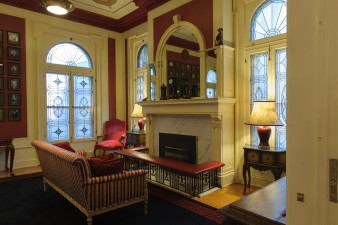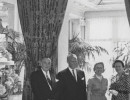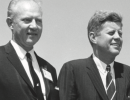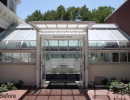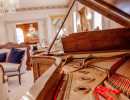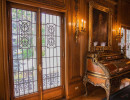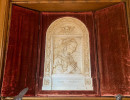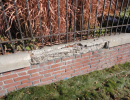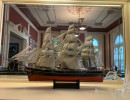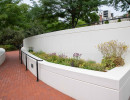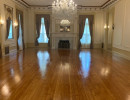Situated atop Logan Hill, the magnificent Governor’s Residence at the Boettcher Mansion and its one-acre grounds has entered its second century of helping to create Colorado history. Since 1908, this engaging 27-room red brick mansion has stood serenely in a neighborhood once referred to as Quality Hill. In 1959, when the Boettcher Foundation gave the property to the State of Colorado, it became the official residence of the Governor’s family. The mansion was listed on the National Register of Historic Places in 1969.
Today the Governor's Residence at the Boettcher Mansion is a treasure that stands as one of our finest symbols for Colorado's state civic heritage.Years of stewardship have served as “stepping stones” to the current and expanded preservation efforts. The residence includes
History of the Residence
1908-1923: Pioneer Colorado leader Walter Cheesman, who along with Territorial Governor John Evans was instrumental in bringing the railroad to Denver, envisioned the home on Quality Hill. He and his teenage daughter Gladys worked with architects on its design. Following his untimely death, his wife Alice and daughter completed the house in 1908. Gladys' wedding to John Evan's grandson was the first event held in the mansion. The stunnign mansion included 27 rooms, a solarium, and an extensive gardens include a rose garden with a central fountain, a lily pool flanked by a pergola, brick paths lined with with evergreens, roses, and columbines, a brick surrounding wall topped by wrought iron and draped in vines, and more.





1923-1959: Colorado leader Claude Boettcher, the son of pioneer businessman Charles Boettcher, bought the home after Alice Cheesman's death in 1923. A man of his times, Claude was an avid traveler and collector. He and his wife Edna expanded the residence with the addition of the glass and marble Palm Room and furnished the home with the art and treasures they found on their travels throughout Europe and Asia. Claude and Edna resided there until death, he passing in 1957 and she a year later. The mansion was then bequethed to the Boettcher Foundation.








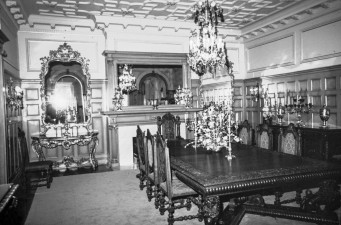



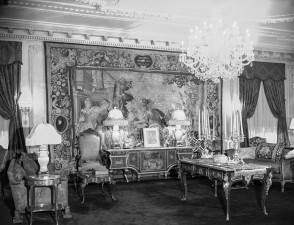
1961-Present: Young Stephen McNichols grew up just blocks away from the Boettcher mansion. In 1959 the state legislature turned down the Boettcher Foundation when it offered the mansion as Colorado’s Executive Residence, due to the expense. However, days before the home was slated for demolition, then Governor Stephen McNichols accepted the house, some say to his political detriment -- for Colorado. Without his stewardship, the stately home would have been torn down. McNichols and his family moved into the new Governor's Residence in 1961.
Colorado's subsequent Governors continued to guide the legacy of the historic mansion as a place where Colorado's leaders meet with other regional, national and international leaders to pursue and ensure the continued growth and prosperity of the State and its citizenry.





Preservation Efforts Over the Years
Throughout the years many First Families have worked to maintain and restore the splendor of the mansion, carriage house and gardens. One of the most extensive preservation efforts was undertaken by former First Lady Frances Owens who raised millions of dollars in private funds to restore the home’s stunning interior, enhance the exquisite gardens and to save the handsome Carriage House and Green House structure from demolition while adding the elegant Boettcher Cabinet Room. The Governor’s Residence Preservation Fund was founded in 2008 to lead the continued preservation and stewardship of Colorado's Home. Our focus includes:
- Colorado’s Home: Preserving the Residence as a showcase of the state’s cultural legacy and as a place for the people of Colorado to enjoy.
- Buildings & Architecture: Historic building structural assessments are prepared to outline critical repairs needed to maintain the integrity and structural soundness of the Residence.
- Collections: Preserving the original Boettcher Collections donated to the state in 1959.
- Gardens & Landscape: Renewal and enhancement projects throughout the Residence grounds.
2022: Tebo Visitors Center Renovation Project
Next time you are here, you will be delighted to see the progress of work being done on the original greenhouse, carriage house, and Tebo Visitor Center. Plans include interior paint, new carpet, lighting, stone replacement, additional millwork, and furniture. This project is made possible by the Ann Penny Fund/Boettcher Foundation, GRPF, and Mandil Inc.






2011-2012: Preserving the Boettcher Collection
When the home was donated by the Boettcher Foundation in 1959, it included Claude and Edna Boettcher's extensive personal collection of hand-crafted furniture, fine art, and valuable collectibles gathered from their extensive travels around the world. The Fund provides curatorial oversight for this approximately 1,500 piece collection, with ongoing work to conduct additional original research about the pieces and their historical relevance and stories. From the cut-glass chandelier that once hung in the White House during the Grant administration, to the Steinway grand piano played by notables such as Liberace and John Denver, to the French Louis XIV styled tulip wood cylinders desk, each piece is a treasure worth preserving for the people of Colorado.
That’s where the Colorado Chapter of Questers, Inc. stepped in. An international organization that focuses on the restoration, preservation and study of antiques, over the years the Colorado Questers have generously donated for the restoration of the Collection and the home and gardens. During the Romer administration they helped to restore the broken upper dish of the lovely goddess of the harvest fountain in the South Terrace Garden that had cracked due to the weight of a severe snowfall. In 2011, they restored the superb Gobelin tapestries of the "seasons" series depicting autumn and winter that hang in the Residence’s elegant Drawing Room. Literally hanging in tatters, these exquisite works of art have new lives thanks to the Colorado Questers.
In 2012 the Fund worked to restore the very large French tapestry gracing the Residence Grand Hallway which had to be mounted and repaired in a specialized workshop in Turkey. The Questers once again stepped forward to contribute a portion towards the total cost of this restoration work. We offer our sincere thanks and recognition to an amazing Colorado organization from “Colorado’s Home.”















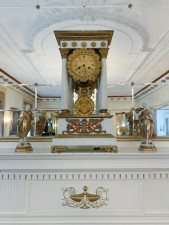

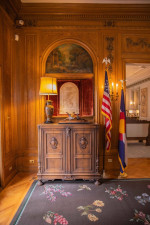


2010s: Historic Gazebo
The historic Gazebo on the East lawn is fully restored. Thanks to generous grants from the State Historic Fund, the Colorado Questers and Gates Family Foundation, this charming gazebo has new life. The original benches had been removed which caused the stone poritions of the gazebo to shift and twist under the weight of the iron dome. We repaired the stone pillars and reconstructed the benches so this Italian relic can live on for another 100 years.


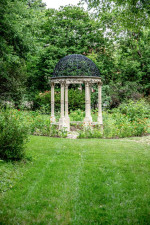


2010s: Historic Perimerter Fence
We have recently completed Phase IV of the historic perimeter fence restoration project. This project included the restoration of the historic masonry, pillars, and decorative fence line around the mansion. To date we have completed restoration of the fence along Eighth Avenue and along Logan Street. This project was possible because of a grant from the State Historical Fund.



2010s: Cutty Sark Model Ship
Mr. Boettcher loved to collect model ships-in abundance. So much so that Mrs. Boettcher found them cluttering her beautifully decorated home. She requested that he move his beloved collection elsewhere. His solution? Build a small restaurant at the Brown Palace to display the ships and call it the Ship Tavern. The Preservation Fund restored the “Cutty Sark” one of two ships that remain at the Residence. It is on display in the "Governor's Room."



2005: Landscape Updates
In 2005 landscape architects at Civitas and Lime Green Design developed the lower terrace: A semi-circular lawn is enclosed by a cascade fountain of locally-sourced rose granite while groupings of pinyon, juniper, and native grasses soften the hardscape.
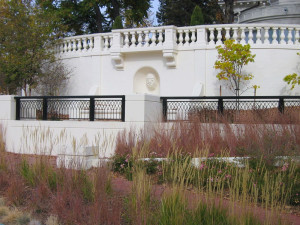



1980's: Restoration Work
The structure was restored in the 1980s by architect Edward White, Jr.


